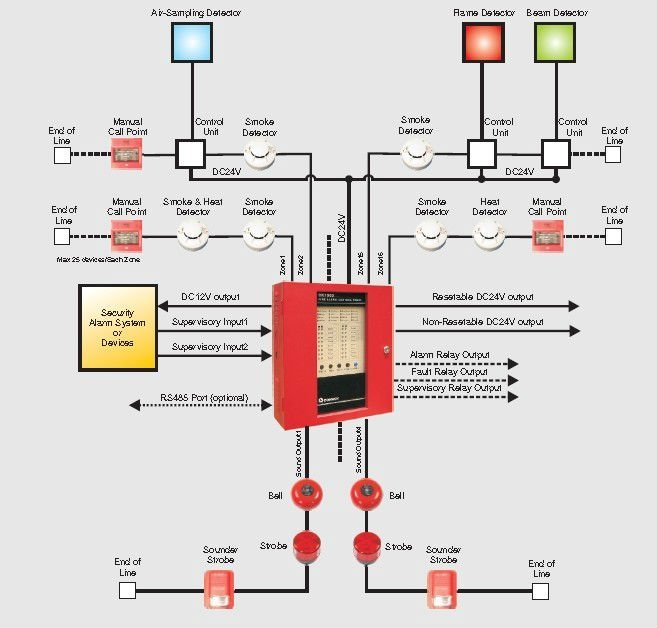Fire Alarm System is a feature of a building for protection against the damages of fire. Is a key element in any overall risk management strategy. It can help limit losses in buildings and facilities by indicating and warning of abnormal conditions, summon appropriate aid and control emergency functions.
Basic components of a fire alarm system are alarm-initiating-device circuits (IDC) or signaling-line-circuits (SLC) to which fire detectors, manual alarm stations, water-flow alarm devices or other initiating devices are connected. These circuits transmit alarm indication to a control panel called fire alarm control unit (FACU), powered by a primary power supply and a secondary power supply. Notification-appliance-circuits (NAC) to which alarm signaling devices as strobe-lights, horns, speakers, off-premises alarms and trouble signals are connected.

Fire Alarm Control Units (FACU) are the central component of the system, it handles all signal transmitting and processing, and carries the operation of the system. They are classified in three types.
Conventional FACU are designed to accept initiating devices that provide either alarm or normal status information, that is either on or off. Devices are arranged by so called zones, each zone corresponds to a different IDC.
Addressable FACU, in addition to on/off information, the exact location of the initiating devices are also included in the communication channel, this information is generated electronically and transmitted though SLC.
Addressable/Analog FACU allows the initiating devices to report their exact location and alarm threshold status, it can monitor a smoke detector cleanliness helping to determine if the detectors needs to be serviced before it alarms needlessly. Also allows to adjust sensitivity levels individually to enhance detector response within it surrounding environment.
Due the use and wider adoption of recent technologies for data transmission, former circuits classification has been deprecated and since NFPA 72, 2010 edition, a new chapter provided circuit and pathway performance (class) designations and pathway survivability level designations as follows:


SYSTEMS TYPES
FIRE ALARM SYSTEMS
Protected Premises (local) Fire Alarm Systems, entire system operates in the protected premises by indicating the existence of heat, fire, smoke, or other emergencies impacting the protected premises.
Household Fire Alarm Systems, to provide a reliable means to notify the occupants of the presence of a threatening fire and the need to escape to a place of safety before such escape might be impeded by untenable conditions in the normal path of egress.
SUPERVISING STATION ALARM SYSTEMS
Central Station Service Alarm Systems, connect Protected Premises to a central station (privately owned) whose function is to monitor the communication channels, record, report any alarm, trouble or supervisory signal from the protected premises, and take actions at the central station such as notifying municipal fire department of a fire, inform the police department of intrusion, or notifying the owner of a supervisory or trouble signal.
Proprietary Supervising Station Alarm Systems, similar to a central station system, but operated by the owner of the protected property.
Remote Supervising Station Alarm Systems, connects a protected premises to a remote station such as fire department or police station, over regulated communication channels regarding Electromagnetic radiation, Use of radio frequencies and connection to the public switched telephone network of telephone equipment, systems, and protection apparatus.
Supervising Station Alarm Systems, provide connection between a Protected Premises System and a continuously attended supervised station, its main purpose is to handle and process alarm signals to a communication center.
PUBLIC EMERGENCY ALARM REPORTING SYSTEMS
Public Emergency Alarm Reporting Systems, consist of alarm boxes and alarm processing equipment that communicate on a wired or wireless network(s), one-way or two-way, include systems that use a communications infrastructure that is publicly owned, operated, and controlled.
Auxiliary Alarm Systems, include equipment and circuits necessary to connect a protected premises to a public emergency alarm reporting system.
EMERGENCY COMMUNICATIONS SYSTEMS
Are for the protection of life by indicating the existence of an emergency situation and communicating information necessary to facilitate an appropriate response and action, shall be capable of the reproduction of prerecorded, synthesized, or live messages. Classified as one-way or two-way systems.
Matching the Fire Alarm System to the protection needs is the work of an specialized Engineer, who leads toward consensus between owners, stakeholders and governments, regarding the optimum method of protecting life, assets and environment from hazards of fire.
References
-NFPA 72, National Fire Alarm and Signaling Code